Last spring, Lake Erie provided the absolute best trophy walleye fishing
this author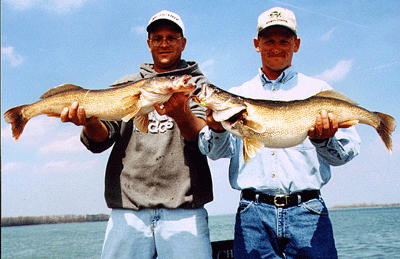 has ever experienced. We managed to catch 145 walleyes that measured at
least 10-pounds on my specialized charter boat, a decked out Lund - Baron.
My success was certainly not a fluke either. Several of my fishing
has ever experienced. We managed to catch 145 walleyes that measured at
least 10-pounds on my specialized charter boat, a decked out Lund - Baron.
My success was certainly not a fluke either. Several of my fishing
buddies also got in on the awesome action, which peaked during mid-April
in the western basin.
Need more convincing? The Professional Walleye Trail (PWT) held a
tournament out of Port Clinton last year April 17-19. During the tournament,
the pros took 346 walleyes that weighed from 10 to 14.27 pounds! Tommy
Scarlis, who won the tournament, managed to weigh 15 walleyes that weighed
138.28 pounds. Pro angler - Ted Takasaki managed five walleyes in one day
that weighed an eye popping 53.2 pounds! Nearly every PWT record was
shattered during the event and the awesome fishing was spread out all over
the East half of the Western Basin. In addition, during the same time
period of the tournament, we caught boatloads of hawg' walleyes fishing the
Michigan waters of Erie.
Where’d All the Big Walleyes Come From?
Mike Thomas, a biologist for the Michigan DNR, says, "Those big, trophy
class fish that were caught last year could have come from ten different
year classes, but they were certainly at least 8-10 years old." He explained
further, "Walleyes have a pretty fast growth rate on Lake Erie, at least
until they reach about 26". At that stage of their life, they slow down
considerably. We've been conducting on ongoing walleye age/growth study on
Erie for many years. Scale samples are taken from fish and analyzed under a
microscope. Determining the age of fish from scale samples has proven
more accurate than the ongoing tagging studies, which are more valuable for
migration data. The tags seem to slow the growth of the walleyes some."
Thomas went on to say, "Once walleyes reach a certain size, and it varies
with each individual fish, the growth rate slows to about 1/4 to 1/2 inch
per year. Females tend to be larger on average than males, however we do see
some extremely large males coming from Lake Erie from time to time.
One was checked last year that measured 32-inches!" He concluded,
"Walleyes that live to 10-years and beyond are hard to age using scale
samples because of distortion. Walleyes have been known to live for 15 years
or more. We still see some walleyes that show up from the huge hear classes
of 1982 and Those 1982 fish will be 21 years old this year." Gary Towns is
Michigan's Supervisor of the Lake Erie Management Unit.
He provided me with some information on walleye year class estimates and
overall survival rates.
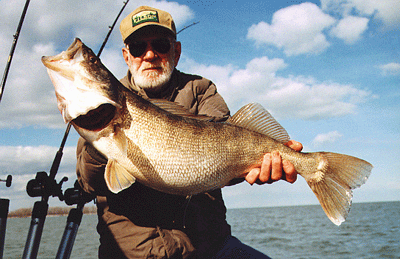 Towns
said, "After one year, walleyes experience a 30 percent mortality rate each
year. Once they attain a size where other fish and birds can't eat them,
that mortality rate drops significantly. Still, walleyes only have an
average life-span of 3-4 years, so walleyes that attain trophy proportions
are very fortunate indeed."
Towns
said, "After one year, walleyes experience a 30 percent mortality rate each
year. Once they attain a size where other fish and birds can't eat them,
that mortality rate drops significantly. Still, walleyes only have an
average life-span of 3-4 years, so walleyes that attain trophy proportions
are very fortunate indeed."
Since we know that it takes walleyes at least 8-10 years or more to reach
ten-pounds, and growth rates drop significantly once they get old, then
those big walleyes are likely a mixture of many different year classes.
Gary Towns passed along these statistics: "1982 was the best year ever
recorded for walleye recruitment. An estimated 1,000,000 walleyes made it to
two-years-old that year. 1983 was a poor year with little recruitment.
1984-85 were OK years. 1986 was the second best year on record with over
60,000,000 walleye living two years. 1987-88 produced 15,000,000 each year.
1989 kicked out 10,000,000. 1990-91 each had 28,000,000. 1992 was a poor
year, while 1993 bounced back with 20,000,000 and then 30,000,000 in 1994.
1995 was the worst year recorded, but 1996 was the third best year with
40,000,000. 1997 saw 15,000,000 walleyes make it two years, and 1998 had
10,000,000. 1999 was another good year with 30,000,000, but 2000 was dismal.
2001 was a good year with an anticipated 30,000,000. Preliminary samplings
for 2002 indicate a poor hatch. Year classes are greatly influenced by
weather events. Sedimentation from runoff and heavy wave action, which
covers over the eggs, is the leading cause of poor recruitment. The heavy
rains and winds of the spring of 2002 didn't do Lake Erie's walleyes any
favors."
Most of the trophy walleyes in the system today probably came from the
1990, 1991, 1993 and 1994 year classes. We should also have awesome numbers
of big fish coming from 1996 over the next few years. Mike Thomas believes
that there are walleyes living in Lake Erie, from the 1982 and 1986 year
classes that will weigh 15-20 pounds when full of roe.
Tactics to Catch the Big Ones
By far, trolling accounts for the vast majority of trophy walleyes on
Lake Erie. Mark Sak is a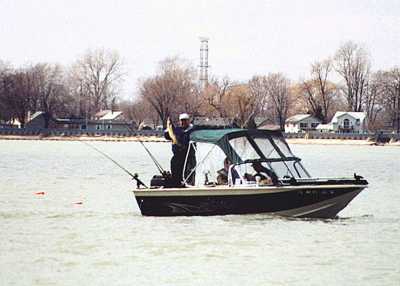 touring walleye pro who last year placed fourth at Port Clinton and second
overall in the PWT's eastern division. He says, "Every pro that fished the
2002 Port Clinton tournament trolled with stick baits. A couple guys tried
pulling crawler harnesses during the prefish, but it was plastic all the way
on the tournament days."
touring walleye pro who last year placed fourth at Port Clinton and second
overall in the PWT's eastern division. He says, "Every pro that fished the
2002 Port Clinton tournament trolled with stick baits. A couple guys tried
pulling crawler harnesses during the prefish, but it was plastic all the way
on the tournament days."
Mark Sak went on to say, "Most of the pros trolled Reef Runners and
Rapala Husky Jerk Baits. I caught most of my fish in 22-23' of water and the
fish were suspended in clusters at varying depths. We learned that our best
success came by running the lures about 5-10' above the fish. Keeping the
baits above the fish allowed them to see the baits overhead and come up for
strikes. We set the lures back 50-120' behind inline boards using 10
pound-test, clear monofilament line."
Sak continued, "The fire-tiger Reef Runners seemed to work best in the
morning, while blue and Tennessee-Shad Husky Jerks worked best later in the
day. Most of top placing pros attached a piece of crawler to their crank
baits, which made the walleyes hold on longer increasing the strike to catch
ratio."
Some unique trolling patterns produced well in the tournament. Mark Sak
said, "I set all of my lines on one side of the boat and kept them running
close together to imitate a school of baitfish. Plenty of S-curves were
incorporated into our trolling pattern and we tried to maintain a
trolling speed of 1.2 miles-per-hour."
My favorite cold water tactic is to troll very slow using subtle action
stick baits such
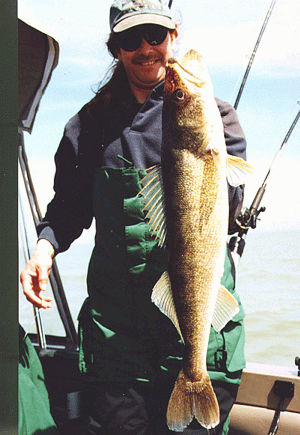 as
Jr. Thundersticks, Rapala Husky Jerks and Rattlin' Rouges. Dark colors seem
to work best in cold water. Black/gold and
as
Jr. Thundersticks, Rapala Husky Jerks and Rattlin' Rouges. Dark colors seem
to work best in cold water. Black/gold and
black/silver finishes are my bread and butter, but lime green had its
good days last year too. I troll at speeds that do not exceed one mile per
hour.
When the water starts to warm up past 47 degrees, I switch over to faster
action crankbaits and kick up the speed to 1.5. Shad Raps, Reef Runner Lil-Rippers,
Rattlin' Rogues and CC-Shads are all good choices. As a general rule, I use
dark colored baits in dirty water and bright, florescent patterns when the
water is clear. It often pays to experiment though.
Hot Spots
The Port Clinton PWT tournament was won near Kelleyes Island. Other spots
that produced top places were Rattle Snake Island, Green Island, Niagara
Reef and West Reef. Mark Sak fished the water just out from Port Clinton Bay
and said, "The bigger walleyes seemed to stick around more and stay in one
place in shallower water. The fish that roamed in deeper water moved around
a lot and were harder to stay on."
The Port Clinton PWT event had a tournament boundary that excluded
Michigan's waters. Even though I am licensed to charter in both Michigan and
Ohio waters, I haven't fished in Ohio during March or April since 1999. The
Michigan waters are that good, and in my opinion they offer one of the best
trophy walleye areas during early spring in the world. The good news is the
action is close to shore so the fishery is accessible to smaller boats. In
fact, last year, my most consistent action occurred in water less than
10-feet deep between the Detroit and Maumee Rivers, which is a major
staging area for pre and post spawn walleyes. If you have any questions,
[email protected] is my email.
Suggested Captions:
1) Here are two nice walleyes taken during mid-April: The one on the left
is
a male, the sag-belly on the right is an egg laden female. Photo by
Michael
Veine.
2) 10-pounders like this one were common catches last spring on Lake
Erie.
Photo by Michael Veine.
3) Trolling stick baits behind in-line planer boards is the most
productive
tactic for trophy walleye during early spring on Lake Erie. Michael Veine
photo.
5) Last spring came late with snow storms and cold weather keeping the
big
walleyes in the Western Basin throughout April and into May. Michael
Veine
photo.
6) Long, lanky males and spawned-out females made up a lot of the trophy
walleye catch last spring. Michael Veine photo.
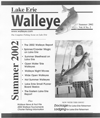
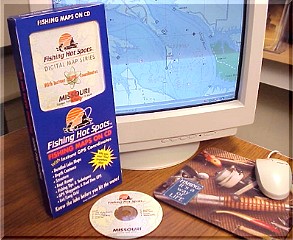



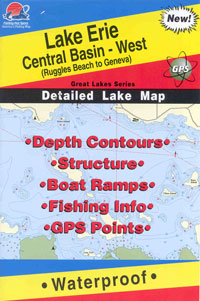
 has ever experienced. We managed to catch 145 walleyes that measured at
least 10-pounds on my specialized charter boat, a decked out Lund - Baron.
My success was certainly not a fluke either. Several of my fishing
has ever experienced. We managed to catch 145 walleyes that measured at
least 10-pounds on my specialized charter boat, a decked out Lund - Baron.
My success was certainly not a fluke either. Several of my fishing  Towns
said, "After one year, walleyes experience a 30 percent mortality rate each
year. Once they attain a size where other fish and birds can't eat them,
that mortality rate drops significantly. Still, walleyes only have an
average life-span of 3-4 years, so walleyes that attain trophy proportions
are very fortunate indeed."
Towns
said, "After one year, walleyes experience a 30 percent mortality rate each
year. Once they attain a size where other fish and birds can't eat them,
that mortality rate drops significantly. Still, walleyes only have an
average life-span of 3-4 years, so walleyes that attain trophy proportions
are very fortunate indeed." touring walleye pro who last year placed fourth at Port Clinton and second
overall in the PWT's eastern division. He says, "Every pro that fished the
2002 Port Clinton tournament trolled with stick baits. A couple guys tried
pulling crawler harnesses during the prefish, but it was plastic all the way
on the tournament days."
touring walleye pro who last year placed fourth at Port Clinton and second
overall in the PWT's eastern division. He says, "Every pro that fished the
2002 Port Clinton tournament trolled with stick baits. A couple guys tried
pulling crawler harnesses during the prefish, but it was plastic all the way
on the tournament days."  as
Jr. Thundersticks, Rapala Husky Jerks and Rattlin' Rouges. Dark colors seem
to work best in cold water. Black/gold and
as
Jr. Thundersticks, Rapala Husky Jerks and Rattlin' Rouges. Dark colors seem
to work best in cold water. Black/gold and